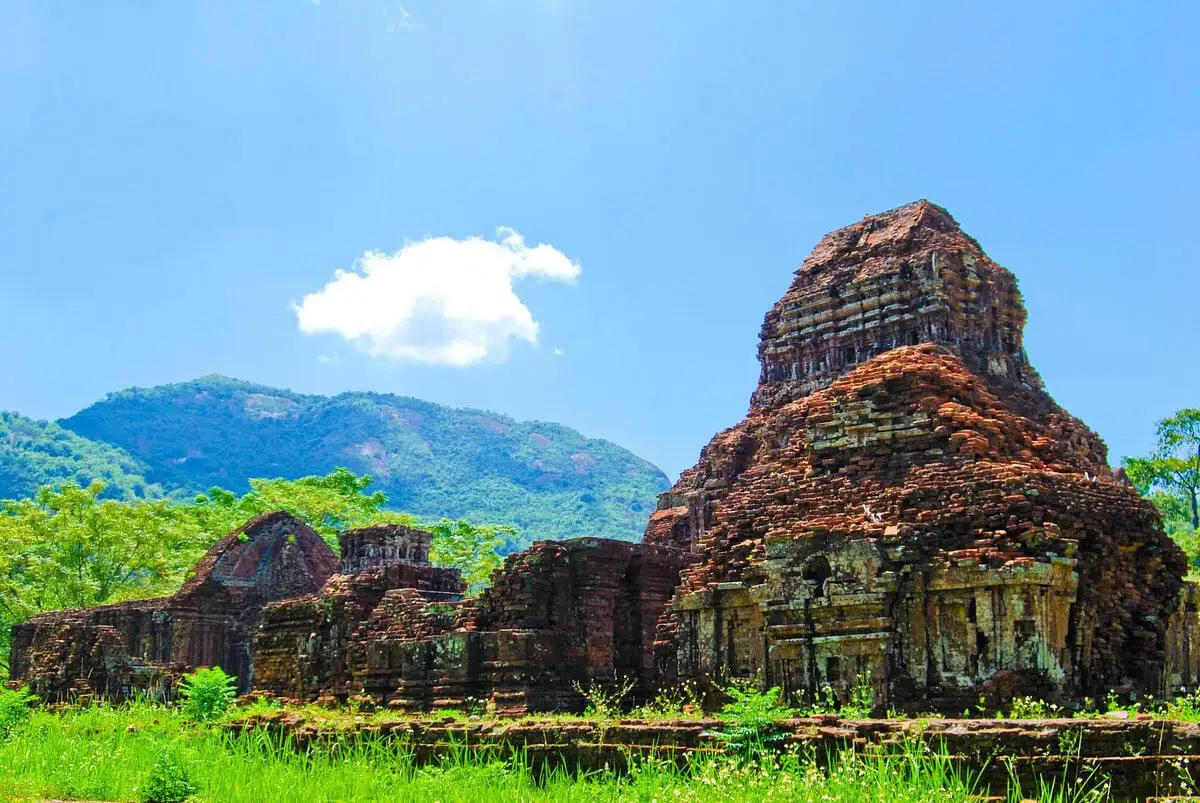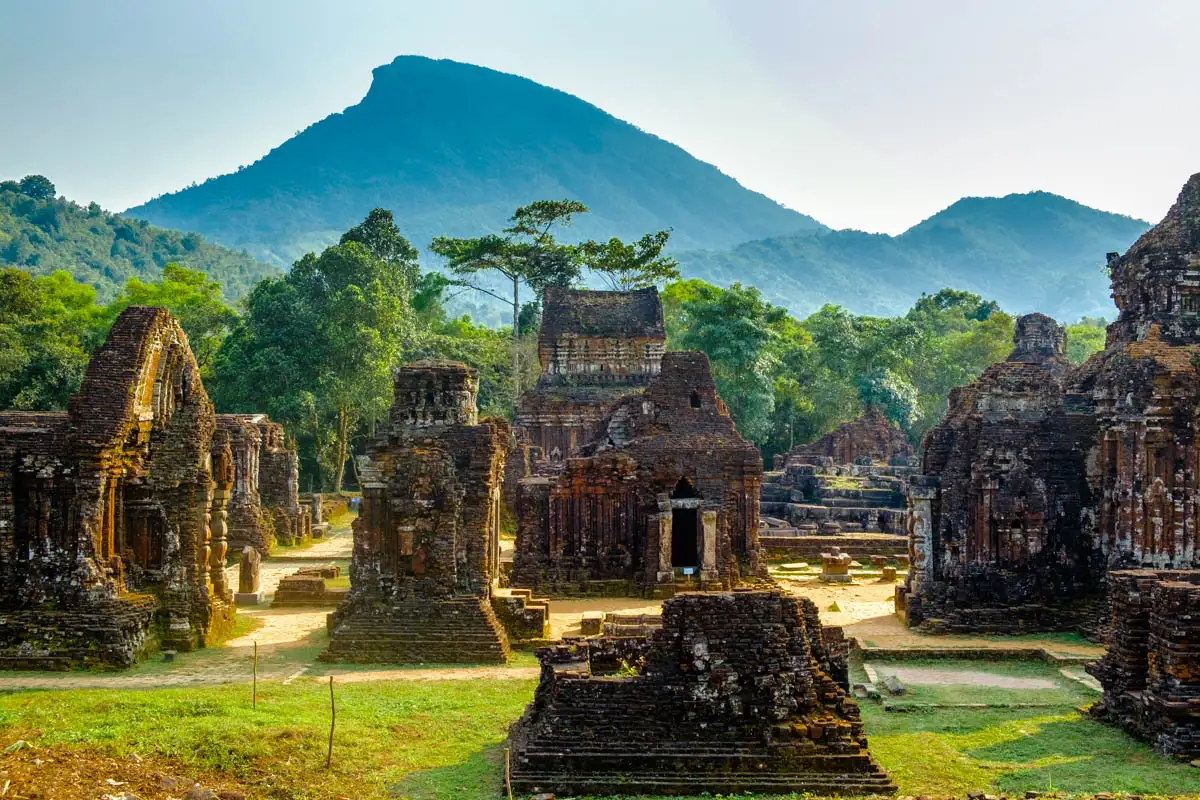My Son Sanctuary Vietnam – Champa cultural heritage
My Son Sanctuary stands as one of the most iconic symbols of the ancient Champa civilization. With a series of weathered stone temples, this site is not only an archaeological marvel but also a living repository of historical, cultural, and religious values that have endured for over a thousand years. This article will guide you through the most fascinating aspects of My Son, from its artistic architecture to its rich cultural experiences.
Introduction to My Son Sanctuary
If you’re fascinated by ancient relics and mysterious histories, My Son Sanctuary is a destination you simply can’t miss. Nestled in a lush green valley in Duy Xuyen District, Quang Nam Province, this sacred site was once the religious heart of the Champa Kingdom for more than a thousand years. The ancient brick towers, intricately carved stone bas-reliefs, and moss-covered ruins create a spiritual and enchanting atmosphere unlike any other.

With its outstanding global value in terms of history, architecture, and religion, My Son Sanctuary was recognized as a UNESCO World Cultural Heritage Site in 1999. Today, the site remains a peaceful, sacred, and somewhat mystical destination, perfect for travelers who love to delve deep into ancient cultures and witness the timeless beauty of a once-glorious Champa civilization.
My Son Sanctuary guide:
- My Son Sanctuary ticket prices:
- Adults: 100,000 VND per ticket (Vietnamese), 150,000 VND per ticket (foreigners)
- Children under 15: Free of charge
Ticket includes electric shuttle service to the main tower area, access to the museum, and a traditional Cham dance performance.
- My Son Sanctuary opening hours: Daily, from 6:00 AM to 5:30 PM
The best time of year to visit My Son is from February to April. During these months, the weather is dry, mild, and comfortable, which makes it ideal for walking, photography, and exploring the ruins at a relaxed pace.
For those who want to experience cultural activities and performances, the period from May to August is also a great choice. Although the weather can be hot, the sanctuary often hosts vibrant Cham dance shows and festive programs. From October to December, the site enters the rainy season. While it may be wet and a bit slippery, the misty, nostalgic atmosphere adds a different charm that appeals to those who enjoy quiet, reflective travel moments.
My Son Sanctuary history
My Son Sanctuary is not just a complex of ancient temples – it is a silent witness to the long and profound history of the Champa Kingdom. According to archaeological findings and ancient inscriptions, the first temple at My Son was built in the 4th century during the reign of King Bhadravarman. Initially, this sacred site served as a place of worship and royal rituals dedicated to Shiva – the supreme god in the Brahmanic religion embraced by the Cham people.
Over the centuries, successive Cham kings continued to construct, expand, and restore the sanctuary. My Son reached its peak between the 8th and 13th centuries, becoming the largest religious and cultural center of the Champa Kingdom. More than 70 structures were erected, including the main towers (Kalan), auxiliary shrines, reception halls, and altars – all arranged harmoniously to reflect the Cham people’s sophisticated sense of architecture and art.
By the 15th century, as the Champa Kingdom declined and eventually collapsed, My Son Sanctuary was gradually abandoned. However, its spiritual and artistic values remained powerful and continued to attract researchers and explorers. During the French colonial period, Western scholars began excavating, documenting, and attempting to restore many of the structures.
Tragically, parts of the sanctuary were heavily damaged during the Vietnam War due to bombings. Yet, many towers have remained relatively intact and still hold immense archaeological significance. Since 1975, the Vietnamese government has made major efforts to preserve and restore the site, with help from international organizations – especially after UNESCO recognized My Son as a World Cultural Heritage site in 1999.
Today, My Son Sanctuary is not only a major tourist attraction in Central Vietnam, but also a spiritual and historical link between the past and the present. Each brick, each carving, and every weather-worn relic tells a powerful story – inviting visitors to discover the mysteries and grandeur of a once-glorious civilization.
A masterpiece of Cham Architecture
My Son Sanctuary is not only a place that preserves history and spirituality but also a living masterpiece of Cham creativity and architectural brilliance. What makes this site so unique and mysterious is the way the temples were built – an impressive blend of nature and human craftsmanship.
One of the most striking features is the use of red baked bricks as the main construction material. These bricks were made with a special technique that gave them incredible durability. What’s even more fascinating is that the bricks were joined together without using any mortar, yet they still fit tightly and have remained strong for centuries. The secret behind this ancient technique is still a mystery that continues to amaze modern researchers.

Each tower complex at My Son typically includes:
- A main tower (Kalan), which is the tallest and most important structure, dedicated to the Hindu god Shiva.
- Smaller surrounding towers, which honor other deities or members of the royal family.
- Additional structures such as stairways, altars, and beautifully carved statues.
The architectural style follows classic Hindu temple design. The tower roofs are pointed and shaped to represent Mount Meru – the sacred mountain believed to be the center of the universe in Hindu belief. The walls are covered with intricate carvings showing Hindu legends, graceful Apsara dancers, and divine figures like Ganesha (the elephant-headed god), Garuda (the bird god), and spiritual symbols like Linga – Yoni.
Another fascinating aspect is how the towers are grouped into different clusters, each with its own unique style and decoration. These clusters reflect the evolution of Cham architecture over many centuries:
- Group A is the oldest and largest, built around the 7th century. It features simple yet powerful carvings.
- Groups B, C, D, and G showcase more complex layouts and detailed decorative patterns, highlighting the artistic progress of later Cham dynasties.
Is My Son Sanctuary worth it? Don’t miss these authentic experiences at this historical site!
At My Son Sanctuary, visitors are not only amazed by the magnificent ancient towers, but also immersed in a festive atmosphere, where the cultural heartbeat of the Champa civilization still echoes quietly through the ages. Here are some remarkable experiences you shouldn’t miss when exploring this sacred land.
Admire 6 rare national treasures
One of the most captivating aspects of My Son Sanctuary is the presence of six artifacts that have been recognized as National Treasures. These are not only ancient works of art but also powerful cultural and religious symbols of the once-glorious Champa civilization. Each treasure tells its own story, showcasing the exquisite craftsmanship and unique aesthetic sensibility of the ancient Cham people.
Among the most notable are the imposing statue of the god Shiva, the fertility-symbolic Linga – Yoni. Another treasure is the altar shaped like an elephant-lion hybrid, symbolizing the harmony between natural and spiritual elements.
Walk the 8-meter-old path
At the My Son Sanctuary, one of the most unique experiences for visitors is walking on an ancient stone path about 8 meters wide and over 200 meters long. This path connects the main entrance area to the central tower group A – the most important religious site of the ancient Champa kingdom. It is the only remaining ancient road in the complex, discovered and restored during archaeological excavations in the late 20th century.
The path is paved with large sandstone slabs, neatly aligned and relatively flat, showcasing the advanced construction skills of the Cham people. According to researchers, this was the main ceremonial route used for sacred processions, where kings, high-ranking priests, and ritual delegations passed during major religious festivals. Walking along this path, visitors can clearly observe remnants of ancient Cham architecture, such as altars, foundation bases, and temple towers on both sides.
Today, the path is well-preserved and open for tourists as a main route to explore the sanctuary. It conveniently leads to key tower groups such as A, B, C, and D, while also giving visitors a better understanding of the spatial organization and scale of religious ceremonies held by the ancient Cham people. It’s also a great photo spot, offering memorable moments of exploring a thousand-year-old heritage site nestled in the lush forests of Quang Nam.
Enjoying the Apsara dance
One of the most captivating cultural experiences at My Son Sanctuary is watching the traditional Apsara dance – a performance deeply rooted in the spiritual life of the Cham people. These shows are usually held at fixed times during the day (typically from 9:00 AM to 10:30 AM and from 2:00 PM to 3:30 PM) at a small stage near the entrance to the heritage site.
The Apsara dance is inspired by the celestial nymphs of Hindu mythology. The dancers, dressed in colorful traditional costumes and adorned with intricate headpieces, move gracefully to the rhythm of the Paranung drums and Saranai flutes. Every hand gesture, eye movement, and delicate spin is carefully choreographed to express themes of fertility, feminine beauty, and the spiritual connection between humans and deities.
Visitors can enjoy the performance in the shade of surrounding trees, amidst the ancient atmosphere of the sanctuary. This is more than just an artistic show, it’s a window into the soul of Champa culture, a once-flourishing civilization in Central Vietnam. After the performance, guests often have the chance to interact with the artists, take photos, and learn more about the meanings behind the costumes, props, and dance movements.
Join the Kate Festival at My Son
If you visit My Son Sanctuary around September or October, you may have the chance to witness the Kate Festival – one of the most important religious celebrations of the Cham people who follow the Brahman religion. Although the festival in My Son is smaller than in Ninh Thuan, it still retains the essential rituals and cultural elements that make it deeply meaningful.

The Kate Festival at My Son is usually held at the central group of Cham towers. The event begins with the ceremonial opening of the temple gate, followed by the procession of the sacred costumes that are carried into the main sanctuary. This is then followed by traditional offerings of betel leaves, areca nuts, rice, fruit, and wine to the ancestral deities. A highlight of the ritual is the symbolic bathing of the Linga–Yoni statues, which represent fertility and harmony between male and female energies in Cham cosmology.
Throughout the celebration, traditional Cham instruments such as the Paranung drum and Saranai oboe accompany graceful Cham dances. These include the Apsara dance and ritual dances performed by local artists dressed in vibrant traditional costumes, creating a spiritual and festive atmosphere.
Nearby attractions to explore after visiting My Son sanctuary
After immersing yourself in the sacred and mysterious atmosphere of My Son Sanctuary, extend your journey to discover other captivating destinations in Quang Nam. This region boasts an enchanting mix of untouched natural landscapes, rich cultural heritage, and the charming simplicity of local life. Below are some unmissable stops to enrich your itinerary with unforgettable experiences.
Hoi An ancient town
Located about 45km from My Son, Hoi An ancient town is one of Central Vietnam’s most beloved destinations. In contrast to the solemn, quiet vibe of My Son, Hoi An offers a more lively yet graceful ambiance along the riverside. Mossy alleys, tiled-roof houses weathered by time, and the warm glow of lanterns at night all contribute to its poetic and nostalgic charm.
Visitors can take a boat ride on the Hoai River, indulge in local specialties like cao lau, mi Quang, and banh beo, or simply sit at a sidewalk café and watch the world go by. On full moon nights, the lantern festival lights up the town in a magical atmosphere – a perfect chance to immerse yourself in the colorful culture of Hoi An.
For those looking to relax after cultural exploration, Bliss Hoi An Beach Resort & Wellness offers a peaceful coastal escape just a short distance from the town center. With its private beach, wellness services, and elegant design inspired by local traditions, it’s an ideal spot to recharge amid serene nature and gentle ocean breezes.
Read more: Perfect Hoi An itinerary for all travelers
Cham islands
Nature lovers and beachgoers will find Cham Islands (Cu Lao Cham), about 15km from Hoi An, an ideal getaway. The archipelago features a rich marine ecosystem, crystal-clear waters, powdery white sands, and a simple yet vibrant local fishing life. After immersing in the spiritual and cultural depth of My Son, the Cham Islands provide the perfect setting to unwind – whether by swimming, snorkeling among coral reefs, or enjoying freshly caught seafood at rustic seaside eateries.
You can also visit light sightseeing spots such as Hai Tang Pagoda, the Cham well, or the Marine Museum to learn about the islanders’ history and their intriguing ties to Cham culture.
Read more: Discover Cu Lao Cham islands – The green pearl in the heart of the East Sea
Thanh Ha pottery village
On your way from My Son to Hoi An, consider stopping by Thanh Ha Pottery Village, located by the Thu Bon River. This traditional craft village, over 500 years old, invites visitors to watch artisans mold clay into fine pottery by hand – from shaping and spinning to kiln firing. A highlight is the opportunity to create your own ceramic piece as a souvenir, adding a hands-on cultural layer to your trip.
The village also features the Terracotta Park, showcasing clay replicas of iconic architectural landmarks like One Pillar Pagoda, Turtle Tower, and Angkor Wat. This open-air museum is both educational and visually stunning, blending heritage learning with relaxing strolls through its earthy, art-filled landscape.
Tra Kieu Sanctuary
Just 15km from My Son, Tra Kieu was once considered the first capital of the Champa Kingdom. Today, this tranquil area still holds ancient remnants such as fort ruins, temple relics, and Champa artifacts displayed at the Tra Kieu Church museum. Visiting Tra Kieu complements your My Son experience by helping you trace the spiritual and political shifts in ancient Champa history.
Beyond its archaeological value, Tra Kieu is also a revered pilgrimage site, home to the tranquil and picturesque Our Lady of Tra Kieu Church. Set amid lush green surroundings, it offers a quiet place for reflection and a deeper connection to both faith and heritage.
Visiting My Son Sanctuary gives you a unique chance to dive into the rich history and culture of the ancient Champa civilization. Plan your trip to My Son and discover the stories that have shaped this remarkable place today!









